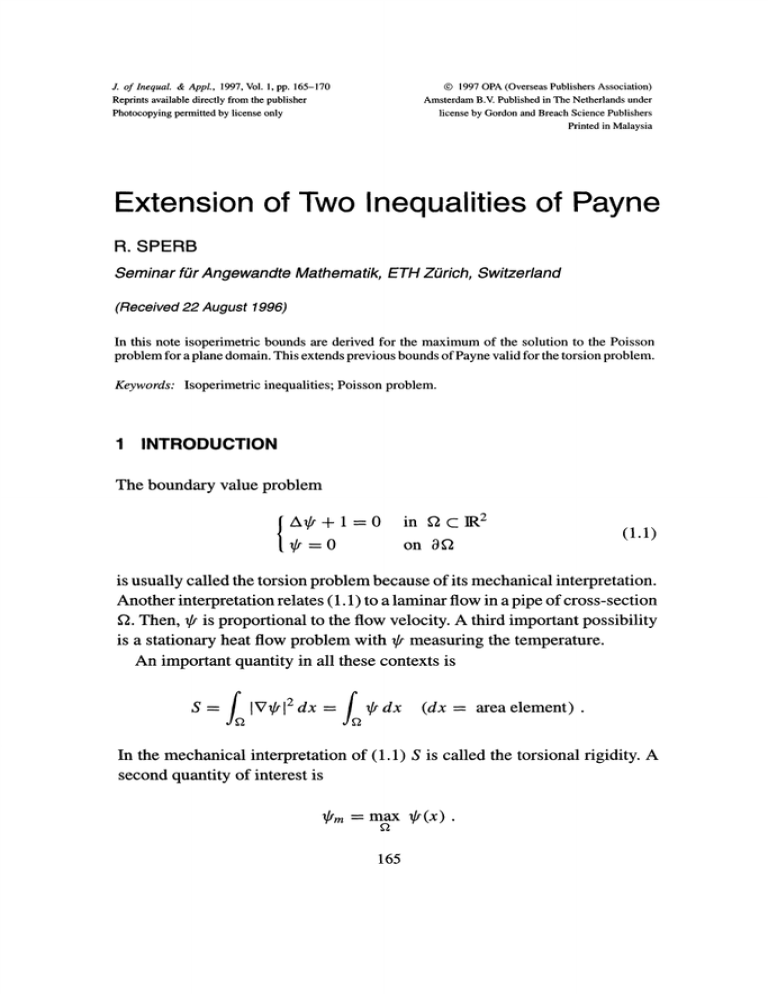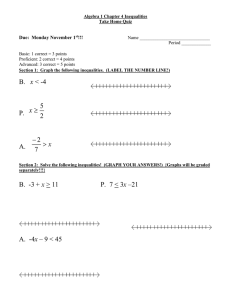Document 10942346
advertisement

J. of Inequal, & Appl., 1997, Vol. 1, pp. 165-170 Reprints available directly from the publisher Photocopying permitted by license only (C) 1997 OPA (Overseas Publishers Association) Amsterdam B.V. Published in The Netherlands under license by Gordon and Breach Science Publishers Printed in Malaysia Extension of Two Inequalities of Payne R. SPERB Seminar for Angewandte Mathematik, ETH ZOrich, Switzerland (Received 22 August 1996) In this note isoperimetric bounds are derived for the maximum of the solution to the Poisson problem for a plane domain. This extends previous bounds of Payne valid for the torsion problem. Keywords: Isoperimetric inequalities; Poisson problem. 1 INTRODUCTION The boundary value problem in on Ar+I=0 p 0 cIR2 (1.1) is usually called the torsion problem because of its mechanical interpretation. Another interpretation relates (1.1) to a laminar flow in a pipe of cross-section f2. Then, p is proportional to the flow velocity. A third important possibility is a stationary heat flow problem with measuring the temperature. An important quantity in all these contexts is s f lvrl2 f dx dx (dx areaelement). In the mechanical interpretation of (1.1) S is called the torsional rigidity. A second quantity of interest is 1/rm max lr(x) 165 R. SPERB 166 Many bounds for lpm and S are known, see e.g. 1, 2, 4]. In particular P61ya and Szeg6 proved that 1/rrn < A (1.2) with A denoting the area of f2 and furthermore that 2 s< A . (.3) Later on Payne [3] proved the sharper inequality S 1/2 (1.4) and also gave the lower bound 4re lpm >_. A (A 2 87/’S) 1/2 (1.5) In all these inequalities the equality sign holds if is a disk. In this note the primary concern is to give an extension of Payne’s inequalities (1.4), (1.5.) to the Poisson problem in the plane, i.e. the boundary value problem Au+p(x)=0 in g2 (1.6) on 02 u=0 where p(x) is a smooth, strictly positive function satisfying A (log p) < K 2p (1.7) for some constant K. If K > 0 an additional requirement is that K f p dx < 4zr (1.8) Remark Problem (1.6) is equivalent to problem (1.1) for a domain on a surface of Gaussian curvature K 2p A(log p) (see [1, 4] for more details). 2 EXTENSION OF PAYNE’S INEQUALITIES The analogue of inequalities (1.4) and (1.5) can be stated as EXTENSION OF TWO INEQUALITIES OF PAYNE THEOREM 167 Suppose p(x) satisfies (1.7) and (1.8) in the simply connected plane domain fa and set Then one has for Um max u the inequalities 1 Um and Um-+- (1- e -Kum) < A 1 (e Kum K) K.S (2.1) 4:re 1) > K.S 4re Equality holds in (2.2), (2.3) if fa is a disk and p is of the form (1 4rg (2.2) q- r2) 2’ positive number distance from the center of the disk. c r Remark For K --+ 0 inequalities (2.1) and (2.2) reduce to the inequalities (1.4) and (1.5) of Payne as a Taylor expansion with respect to K shows. Proof of the Theorem: Let 1-’t be the level-line where u domain enclosed by Ft. We set for v 6 (0, urn) S())=fUm(t,u, ds) and fat the dt, (2.3) p dx =: a(v) (2.4) Then IVul ds dv where we have used Green’s identity and defined the quantity a(v) such that a(O) f p dx =- A and a(um) O Next we make use of the fact that (see 1], p. 53) da dv fr ds P IVul a.e. in (0, urn) (2.5) R. SPERB 168 By Schwarz’s inequality one has I’ulds" P > IVul (2.6) ds At this point we can use Bol’s inequality (see 1], p. 36) which states that if p(x) satisfies (1.7) and (1.8) then ( fr /-ds)Z > a(v)(4yr Ka(v)) (2.7) Combining now (2.4), (2.6) and (2.7) we e led to the inequality d2S K" dv 2 dS dv (2.8) 4 or in equivalent form as > 4 e_ (_Kv dS) dv d e dv v0 to v =Um gives after some Integration of (2.9) from a value v reangement dS 4 > (1 dv vo- K since dS For v0 (2.9) e -K(um-v)) (2.10) O. Um 0 (2.10) reads - 4 A>(1- e_Kum) K or equivalently Um < 1 log (2.11) 4zr ( 4zr-KA ) as noted by Bandle (see [1]). If we now integrate (2.10) one more time from v0 led to IXZul ds S(0) > 4r[ which is inequality (2.1). 1 Um (1 0 to v IVul2dx dt e -Kum) (2.12) ] Um we are S (2.13) EXTENSION OF TWO INEQUALITIES OF PAYNE 169 (For the second equality sign in (2.13), see e.g. [4], p. 190). Inequality (2.2) is obtained in a completely analogous manner: the first integration of (2.9) is now from v 0 to v v0 and the second is from v0 0 to v Um as before. 3 REMARKS -- (a) It was shown by Bandle (see [1]) that S< 47/" log A K 4zr 4r KA If we write (2.13) as S-+- 4zr (1- e -Kum) >" 4r Um and use (2.11).and (2.12), we see that the upper bound for Um given in (2.1) is sharper than the bound (2.12), but it requires the knowledge of S or a close upper bound for S. (b) There are other types of bounds that can be obtained from the differential inequality (2.8). For example if we write it in terms of a(v) as da > 4re Ka(v) drand then change the independent variable and writing u in the place of v it becomes 1 du < (.3.2) da 4re Ka This inequality can be integrated in many ways. As an example we perform a double integration as follows: foA[fsA(_dlg__, in f. .a/ da ds Setting f are ) log ( fo u 2pdx<- 4r-Ka un p dx < foA[fs A da 4r Ka In ds (3.3) upper bound for/gm one has e.g. A 2-1 27rf 2( -K K 4zr K f ) (3.4) R. SPERB 170 If instead of the double integral A f0 fsA S >_ A’um d- 1 "- (47r we select KA). f f0a f A K then we obtain (3.5) (c) A number of other types of bounds for problems (1.1) and (1.6) can be found in 1, 2, 4]. References C. Bandle, Isoperimetric inequalities and applications. Pitman (1980). [2] L.E. Payne, Isoperimetric inequalities and their applications. SlAM Rev., 9 (1967), 453-488. [3] Some isoperimetric inequalities in the torsion problem for multiply connected regions. Studies in Math. Anal. and Related Topics: essays in honor of G. P61ya, Stanford Univ. Press (1962), 270-280. [4] R.P. Sperb, Maximum principles and their applications. Academic Press (1981).



